Don't wanna be here? Send us removal request.
Text
Leading PCB Manufacturers in Canada: Quality and Innovation
Discover the top PCB manufacturers in Canada that specialize in providing high-quality printed circuit boards for various industries, including aerospace, automotive, medical, and consumer electronics. These companies offer a range of services, from prototype development to mass production, ensuring precision engineering and compliance with international standards. With state-of-the-art technology and skilled professionals, Canadian PCB manufacturers are committed to delivering innovative solutions, fast turnaround times, and exceptional customer service. Partner with these trusted manufacturers to meet your electronic design and manufacturing needs.
#pcb manufacturing toronto#printed circuit board design#metal clad pcb#printed circuits#rigid flex pcb#full turnkey pcb services#turnkey pcb services#pcb parts#eagle software#pcb designing#flexible pcb#pcb assembly#printed circuit board manufacturers#pcb manufacturers in canada#circuit board manufacturers in canada#pcb quote#pcb prototype services in canada
0 notes
Text
Leading Circuit Board Manufacturers in Canada: Quality and Innovation
Discover the top circuit board manufacturers in Canada, known for their cutting-edge technology, exceptional quality, and customized solutions. Serving industries like aerospace, medical devices, telecommunications, and automotive, these Canadian manufacturers offer a range of products, including single-sided, double-sided, and multilayer circuit boards. With a focus on precision, durability, and environmental sustainability, they provide fast and reliable services to meet the diverse needs of modern electronics and high-performance applications. For more details visit our website www.crimpcircuits.com
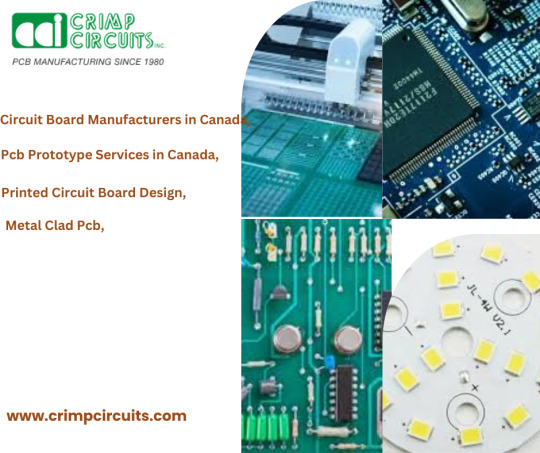
#pcb manufacturing toronto#printed circuit board design#metal clad pcb#printed circuits#rigid flex pcb#full turnkey pcb services#turnkey pcb services#pcb parts#eagle software#pcb designing#flexible pcb#pcb assembly#printed circuit board manufacturers#pcb manufacturers in canada#circuit board manufacturers in canada#pcb quote#pcb prototype services in canada
0 notes
Text
The Benefits and Applications of Rigid-Flex PCBs
Rigid-Flex Printed Circuit Boards (PCBs) are a combination of rigid and flexible circuit technologies, offering a unique solution for complex electronic designs. These boards are increasingly becoming the preferred choice for industries that demand high performance, reliability, and space optimization. In this blog, we’ll explore the key benefits, applications, and why rigid-flex PCBs are an ideal option for modern electronics.
What Are Rigid-Flex PCBs?
Rigid-flex PCBs combine the properties of both rigid PCBs and flexible PCBs into one integrated circuit board. The rigid sections of the PCB provide structure and support, while the flexible sections offer the ability to bend, twist, and fold, making it easier to design complex and compact devices. These boards typically consist of multiple layers of flexible circuits attached to one or more rigid sections, all interconnected with electrical pathways.
The main feature that sets rigid-flex PCBs apart is their ability to eliminate the need for connectors and cables between the rigid sections, allowing for greater mechanical stability and reliability in designs that require flexibility.
Benefits of Rigid-Flex PCBs
Space and Weight Reduction
One of the most significant advantages of rigid-flex PCBs is their ability to reduce both space and weight in electronic devices. By integrating flexible circuitry into the design, engineers can create devices with complex geometries, reducing the need for additional connectors or interfaces. This is particularly important for industries such as aerospace and medical devices, where every millimeter of space and gram of weight matters.
Enhanced Durability
Rigid-flex PCBs are designed to withstand high levels of mechanical stress. The flexibility of the board allows it to bend and flex without damaging the circuits. This durability makes them ideal for applications where the device will experience movement, vibrations, or harsh environmental conditions.
Increased Reliability
By eliminating the need for connectors and cables, rigid-flex PCBs offer a more reliable solution. Connectors are often the weakest points in electronic designs and are prone to failure due to wear and tear over time. Rigid-flex PCBs, with their integrated design, reduce these potential failure points, leading to increased reliability and longer lifespans.
Design Flexibility
Rigid-flex PCBs allow engineers to design circuits that would be impossible or impractical with traditional rigid or flexible PCBs alone. The ability to fold, twist, and mold the flexible sections means that circuits can fit into unusual shapes, allowing for innovative product designs and more compact electronics.
Cost-Effectiveness in Complex Assemblies
While rigid-flex PCBs may initially seem more expensive than traditional PCBs, they can reduce costs in the long run by simplifying assembly processes. With fewer components to connect and less labor required to assemble, the total cost of ownership for devices using rigid-flex PCBs can be lower. Additionally, the improved reliability means fewer repairs or replacements, further reducing overall costs.
Applications of Rigid-Flex PCBs
Rigid-flex PCBs are widely used across various industries due to their unique benefits. Some of the most common applications include:
Aerospace and Defense
In aerospace and defense, every gram of weight and cubic centimeter of space is critical. Rigid-flex PCBs are used in devices such as satellites, missiles, and aircraft components, where their lightweight, durability, and ability to function in harsh environments make them invaluable.
Medical Devices
In the medical industry, rigid-flex PCBs are found in wearable devices, hearing aids, pacemakers, and other compact medical devices. Their flexibility allows for more ergonomic designs that can fit the contours of the human body, while their reliability ensures they function flawlessly in life-critical applications.
Consumer Electronics
From smartphones to wearable technology, consumer electronics are increasingly using rigid-flex PCBs. As these devices become smaller and more powerful, rigid-flex technology offers the ideal solution for fitting complex circuits into compact spaces without sacrificing durability.
Automotive Industry
In modern cars, rigid-flex PCBs are used in sensors, cameras, and infotainment systems. They can withstand the vibrations, temperature fluctuations, and mechanical stress that occur in automotive environments, making them a durable and reliable solution for advanced vehicle technology.
Conclusion
Rigid-flex PCBs offer a powerful combination of flexibility, reliability, and space-saving advantages, making them an ideal choice for industries that require complex, high-performance electronic designs. Whether in aerospace, medical devices, or consumer electronics, the benefits of rigid-flex PCBs are clear: they reduce the need for connectors, improve durability, enhance design possibilities, and ultimately lead to more efficient and reliable products. As electronic devices continue to evolve, rigid-flex PCBs will undoubtedly play an increasingly important role in the future of technology. For more details visit our website www.crimpcircuits.com
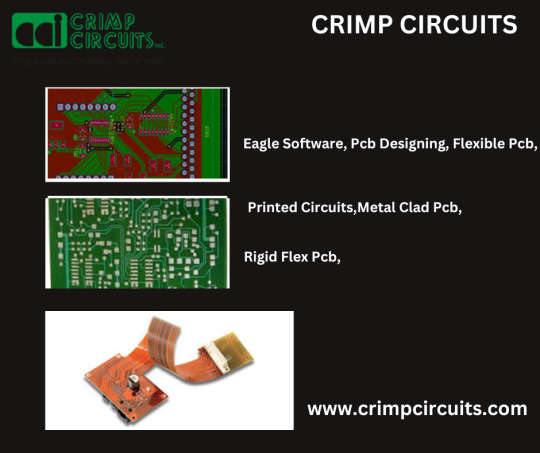
#pcb manufacturing toronto#printed circuit board design#metal clad pcb#printed circuits#rigid flex pcb#full turnkey pcb services#turnkey pcb services#pcb parts#eagle software#pcb designing#flexible pcb#pcb assembly#printed circuit board manufacturers#pcb manufacturers in canada#circuit board manufacturers in canada#pcb quote#pcb prototype services in canada
0 notes
Text
PCB Manufacturers in Canada: Quality and Innovation at Your Fingertips
Canada is home to a diverse range of PCB manufacturers in canada that deliver high-quality printed circuit boards for various industries, including telecommunications, automotive, aerospace, and medical devices. These manufacturers specialize in advanced PCB fabrication, offering services such as prototyping, custom design, and mass production. With a focus on innovation and precision, Canadian PCB manufacturers utilize cutting-edge technology to ensure that their products meet the highest standards of performance and reliability. Whether you need single-layer or complex multi-layer PCBs, the expertise and commitment to quality in Canada’s PCB manufacturing sector can meet your unique project requirements. For more details visit our website www.crimpcircuits.com
#pcb manufacturing toronto#printed circuit board design#metal clad pcb#printed circuits#rigid flex pcb#full turnkey pcb services#turnkey pcb services#pcb parts#eagle software#pcb designing#flexible pcb#pcb assembly#printed circuit board manufacturers#pcb manufacturers in canada#circuit board manufacturers in canada#pcb quote#pcb prototype services in canada
0 notes
Text
PCB Assembly: Expert Solutions for High-Quality Electronic Manufacturing
PCB assembly services involve the meticulous process of soldering and mounting electronic components onto a printed circuit board (PCB) to create a fully functional electronic device. These services are crucial for industries such as telecommunications, automotive, healthcare, and consumer electronics. PCB assembly providers offer a range of options, including surface mount technology (SMT), through-hole technology, and mixed technology, to meet the specific needs of each project. With a focus on quality control, precision, and efficiency, PCB assembly services ensure reliable performance and fast turnaround times, helping businesses bring their products to market quickly and confidently. For more details visit our website www.crimpcircuits.com

#pcb manufacturing toronto#printed circuit board design#metal clad pcb#printed circuits#rigid flex pcb#full turnkey pcb services#turnkey pcb services#pcb parts#eagle software#pcb designing#flexible pcb#pcb assembly#printed circuit board manufacturers#pcb manufacturers in canada#circuit board manufacturers in canada#pcb quote#pcb prototype services in canada
0 notes
Text
Metal Clad PCB: The Backbone of High-Power Electronics
n today’s rapidly evolving electronics landscape, the demand for more efficient, durable, and high-performing components has skyrocketed. One such innovation that has been pivotal in meeting these demands is the Metal Clad Printed Circuit Board (MCPCB). These specialized circuit boards are designed to manage heat dissipation, making them essential in applications requiring high-power or high-temperature performance, such as LED lighting, automotive electronics, and power converters. In this blog, we’ll explore what Metal Clad PCBs are, their advantages, and the industries where they are indispensable.
What is a Metal Clad PCB?
A Metal Clad PCB is a type of printed circuit board that incorporates a metal substrate (typically aluminum, copper, or a combination of both) in place of the conventional fiberglass base found in standard PCBs. The metal base serves as a heat sink, efficiently dispersing the heat generated by the electronic components mounted on the board.
MCPCBs are typically made up of three layers:
Metal Base Layer: This is the core material, often aluminum or copper, selected for its excellent heat conductivity.
Dielectric Layer: A thin, thermally conductive, yet electrically insulating layer that lies between the metal base and the copper circuitry. It allows heat to pass through to the metal core while keeping electrical signals isolated.
Copper Circuit Layer: The conductive layer that houses the circuit paths and connections for electronic components.
This structure allows MCPCBs to handle higher current loads and efficiently transfer heat away from sensitive components, extending their operational life and reliability.
Advantages of Metal Clad PCBs
Efficient Heat Dissipation: One of the primary reasons for using MCPCBs is their ability to dissipate heat much more efficiently than traditional PCBs. High-power components like LEDs or power transistors generate a lot of heat, which, if not properly managed, can lead to system failures. The metal base of the MCPCB acts as a heat sink, drawing heat away from these components and dispersing it effectively, ensuring that the system runs cooler and lasts longer.
Improved Durability: Metal Clad PCBs are more durable and resistant to wear and tear, especially in harsh environments where thermal cycling and mechanical stress are common. The metal core provides additional mechanical strength, making these boards suitable for rugged applications such as automotive electronics, industrial lighting, and aerospace systems.
Enhanced Performance: With efficient thermal management, the performance of electronic components on a Metal Clad PCB is optimized. Components can operate at higher current loads and temperatures without degrading, which is especially important for high-intensity LED lighting and power supply systems.
Cost-Effective Solution: While MCPCBs might have a higher initial cost compared to standard PCBs, their ability to extend the life and performance of electronic components results in long-term cost savings. For example, LED systems using MCPCBs last longer due to better heat management, reducing maintenance costs and replacements.
Compact and Lightweight Design: Despite the inclusion of a metal core, MCPCBs allow for a more compact and lightweight design. This is especially beneficial in applications where space is a premium, such as automotive and consumer electronics. The need for additional heat sinks and cooling systems is minimized, reducing the overall weight and size of the final product.
Applications of Metal Clad PCBs
Given their unique properties, MCPCBs are widely used in various industries, particularly where heat management and reliability are critical.
LED Lighting: The most common application for MCPCBs is in high-power LED lighting systems. LEDs generate significant heat, and without proper dissipation, their lifespan and brightness can be severely affected. Metal Clad PCBs ensure efficient heat transfer, enabling LEDs to run cooler and perform at their best.
Automotive Electronics: In automotive applications, where reliability and durability are essential, MCPCBs are used in headlamps, power converters, and motor controllers. The harsh operating environment of vehicles requires PCBs that can handle extreme temperatures and vibrations, making MCPCBs an ideal solution.
Power Supplies: MCPCBs are widely used in power supplies and power conversion systems. The metal core helps in managing the heat produced by high-power components, increasing the overall efficiency and reliability of the power supply.
Consumer Electronics: Devices like laptops, smartphones, and power banks that require efficient heat management also use MCPCBs to keep components running smoothly without the risk of overheating.
Conclusion
Metal Clad PCBs have revolutionized the way high-power electronics manage heat and deliver performance. Their unique structure allows them to provide efficient heat dissipation, durability, and enhanced performance across a wide range of applications. Whether it's in LED lighting, automotive electronics, or power supply systems, MCPCBs have become the backbone of industries that require reliable and efficient electronic components.
As technology continues to advance and demand for higher power and smaller form factors grows, Metal Clad PCBs will remain at the forefront of innovation, providing solutions that keep modern electronics running efficiently and effectively. For more details visit our website www.crimpcircuits.com
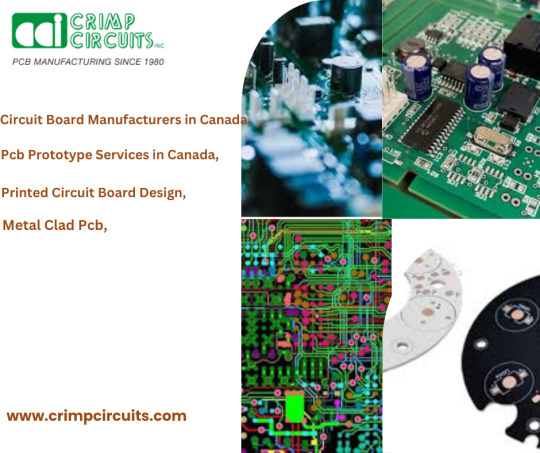
#pcb manufacturing toronto#printed circuit board design#metal clad pcb#printed circuits#rigid flex pcb#full turnkey pcb services#turnkey pcb services#pcb parts#eagle software#pcb designing#flexible pcb#pcb assembly#printed circuit board manufacturers#pcb manufacturers in canada#circuit board manufacturers in canada#pcb quote#pcb prototype services in canada
0 notes
Text
Leading Circuit Board Manufacturers in Canada: Precision and Innovation
Canada is home to a growing number of circuit board manufacturers in canada offering high-quality PCB solutions for a wide range of industries. These manufacturers specialize in producing advanced printed circuit boards (PCBs), including rigid, flexible, and metal-clad designs, serving sectors such as telecommunications, automotive, aerospace, and medical devices. Canadian PCB manufacturers are known for their commitment to precision, quality, and innovation, often providing customized solutions to meet specific client needs. With state-of-the-art facilities and a focus on sustainability, these companies help drive technological advancements while ensuring reliable performance in demanding environments. For more details visit our website www.crimpcircuits.com
#pcb manufacturing toronto#printed circuit board design#metal clad pcb#printed circuits#rigid flex pcb#full turnkey pcb services#turnkey pcb services#pcb parts#eagle software#pcb designing#flexible pcb#pcb assembly#printed circuit board manufacturers#pcb manufacturers in canada#circuit board manufacturers in canada#pcb quote#pcb prototype services in canada
0 notes
Text
Metal-Clad PCBs: Revolutionizing Thermal Management in Electronics
Metal-clad PCBs (Printed Circuit Boards) are specialized circuit boards designed to enhance heat dissipation in high-power applications. Featuring a metal substrate such as aluminum or copper, these PCBs are widely used in industries like LED lighting, automotive electronics, and power conversion. Their superior thermal conductivity ensures efficient heat transfer, improving the performance and longevity of electronic components. Metal-clad PCBs also provide mechanical stability, making them ideal for harsh environments that require robust, reliable circuit solutions. Discover how metal-clad PCBs can optimize your electronic designs by balancing power and heat management effectively. For more details visit our website www.crimpcircuits.com
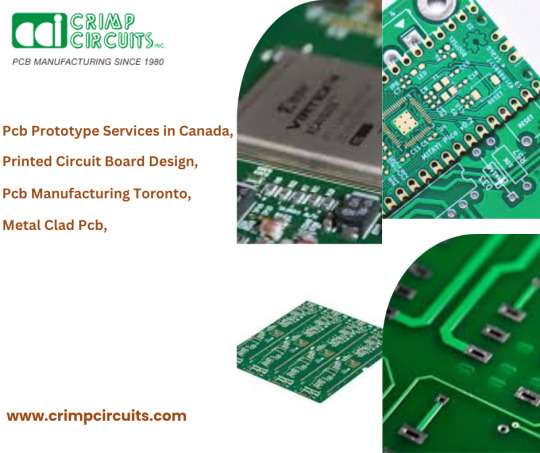
#pcb manufacturing toronto#printed circuit board design#metal clad pcb#printed circuits#rigid flex pcb#full turnkey pcb services#turnkey pcb services#pcb parts#eagle software#pcb designing#flexible pcb#pcb assembly#printed circuit board manufacturers#pcb manufacturers in canada#circuit board manufacturers in canada#pcb quote#pcb prototype services in canada
0 notes
Text
Exploring Rigid-Flex PCBs: A Comprehensive Guide
As electronic devices become more advanced and compact, the need for versatile and space-efficient circuit solutions grows. Rigid-flex printed circuit boards (PCBs) have emerged as an innovative answer to this demand. Combining the best of both rigid and flexible PCBs, rigid-flex PCBs provide increased reliability, flexibility in design, and enhanced performance, making them ideal for various high-tech industries. In this blog, we’ll dive into what rigid-flex PCBs are, their advantages, applications, and why they’re becoming increasingly popular in modern electronics.
What is a Rigid-Flex PCB?
A rigid-flex PCB is a hybrid circuit board that combines elements of both rigid PCBs (the traditional solid boards) and flexible PCBs (bendable, adaptable circuits). Typically, these boards consist of multiple layers, including rigid layers that provide structural support and flexible layers that can be bent or twisted without breaking.
In a rigid-flex PCB, the rigid sections provide the stability and mechanical strength needed for mounting components, while the flexible sections allow the board to fit into spaces where conventional rigid boards wouldn't. The combination enables more complex designs, improved connectivity, and space-saving opportunities.
How Rigid-Flex PCBs Are Manufactured
Manufacturing rigid-flex PCBs is a more complex process compared to traditional PCBs. It requires a combination of both rigid and flexible layers, which are laminated together into a unified structure. This process must be done with precision to ensure that the flexible portions can bend as required without delamination or cracking.
Materials typically used include polyimide for the flexible sections due to its excellent thermal stability and reliability, while FR4 or similar materials are used for the rigid sections. High-quality adhesives and specialized plating are also applied to ensure electrical integrity and durability over time.
Advantages of Rigid-Flex PCBs
Space-Saving Design: One of the primary advantages of rigid-flex PCBs is their ability to reduce space within a device. By combining rigid and flexible components, these boards can be folded or shaped to fit into compact areas, allowing for sleeker, more compact product designs.
Reduced Component Count: Since rigid-flex PCBs can replace multiple individual PCBs with one hybrid solution, they often lead to a reduction in connectors, cables, and other interconnects, simplifying the design and improving overall reliability.
Durability and Reliability: Rigid-flex PCBs are known for their durability, especially in environments that experience vibrations, shocks, or movement. Their design eliminates weak points, such as connectors that can break under stress, making them ideal for dynamic applications.
Improved Signal Integrity: By eliminating the need for multiple connectors and cables, rigid-flex PCBs reduce potential signal interference. The direct, continuous pathways in these boards ensure consistent electrical performance, even in complex designs.
Weight Reduction: In applications where weight is a concern, such as aerospace and automotive industries, rigid-flex PCBs offer a lightweight solution compared to using multiple separate PCBs connected by cables.
Applications of Rigid-Flex PCBs
Rigid-flex PCBs are used in a variety of industries, especially where space, weight, and durability are critical considerations. Some key applications include:
Aerospace and Defense: Rigid-flex PCBs are widely used in aerospace technology due to their lightweight nature and ability to withstand high-vibration environments. They’re commonly found in navigation systems, control units, and satellites.
Medical Devices: The compact and durable design of rigid-flex PCBs makes them ideal for medical devices such as pacemakers, hearing aids, and imaging systems, where reliability and space are crucial.
Wearable Technology: Smartwatches, fitness trackers, and other wearable electronics benefit from rigid-flex PCBs due to their flexibility, allowing for compact, comfortable, and highly functional designs.
Automotive Electronics: In the automotive industry, rigid-flex PCBs are used in safety systems, engine management, and infotainment systems due to their durability in harsh environments.
Consumer Electronics: Smartphones, laptops, and cameras increasingly rely on rigid-flex PCBs to allow for thinner, more lightweight designs without compromising on performance.
Conclusion
As technology continues to advance, the demand for space-efficient, reliable, and durable circuit boards will only grow. Rigid-flex PCBs offer a unique solution that combines the best aspects of both rigid and flexible boards, making them indispensable for industries that require high-performance electronics in compact and demanding environments. For more details visit our website www.crimpcircuits.com
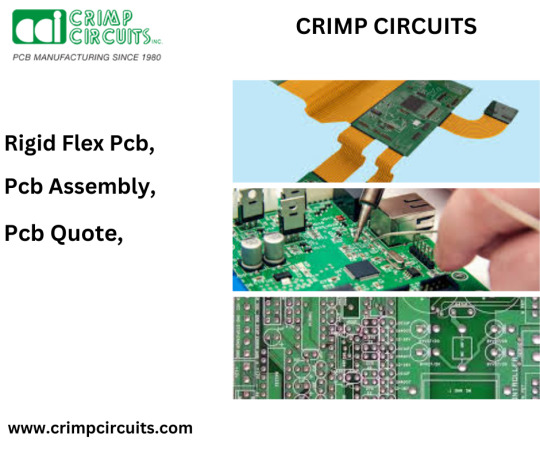
#pcb manufacturing toronto#printed circuit board design#metal clad pcb#printed circuits#rigid flex pcb#full turnkey pcb services#turnkey pcb services#pcb parts#eagle software#pcb designing#flexible pcb#pcb assembly#printed circuit board manufacturers#pcb manufacturers in canada#circuit board manufacturers in canada#pcb quote#pcb prototype services in canada
0 notes
Text
Leading Printed Circuit Board (PCB) Manufacturers
Discover top Printed Circuit Board manufacturers known for their precision, quality, and innovation. These industry leaders specialize in producing printed circuit boards for a wide range of applications, from consumer electronics to advanced industrial systems. With cutting-edge technology and stringent quality control processes, these manufacturers offer custom PCB solutions that meet the highest standards of reliability and performance. Explore their services, capabilities, and how they can help bring your electronic designs to life with efficiency and excellence. For more details visit our website www.crimpcircuits.com
#pcb manufacturing toronto#printed circuit board design#metal clad pcb#printed circuits#rigid flex pcb#full turnkey pcb services#turnkey pcb services#pcb parts#eagle software#pcb designing#flexible pcb#pcb assembly#printed circuit board manufacturers#pcb manufacturers in canada#circuit board manufacturers in canada#pcb quote#pcb prototype services in canada
0 notes
Text
Printed Circuit Board (PCB) Design: A Comprehensive Guide
Printed Circuit Board (PCB) Design involves the creation of a detailed blueprint for electronic circuits. This guide covers the fundamental principles and advanced techniques of PCB design, including schematic capture, layout design, component placement, routing, and fabrication. Learn how to select materials, ensure signal integrity, and adhere to design standards. Whether you’re a beginner or an experienced engineer, this guide provides practical insights and step-by-step instructions to help you design effective and reliable PCBs for a wide range of applications. For more details visit our website www.crimpcircuits.com
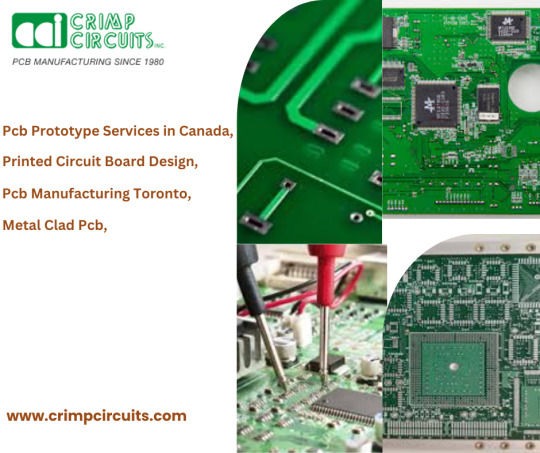
#pcb manufacturing toronto#printed circuit board design#metal clad pcb#printed circuits#rigid flex pcb#full turnkey pcb services#turnkey pcb services#pcb parts#eagle software#pcb designing#flexible pcb#pcb assembly#printed circuit board manufacturers#pcb manufacturers in canada#circuit board manufacturers in canada#pcb quote#pcb prototype services in canada
0 notes
Text
Exploring Rigid-Flex PCBs: The Future of Electronics Design
In today's rapidly advancing technological landscape, innovation in electronics is a constant force driving progress. One of the key innovations that has transformed the electronics manufacturing industry is the development of rigid-flex PCBs (Printed Circuit Boards). These specialized boards combine the durability of rigid PCBs with the flexibility of flex circuits, allowing for compact, reliable, and complex electronic designs.
In this blog, we will dive into the world of rigid-flex PCBs, exploring their structure, benefits, applications, and why they are becoming essential in modern electronic devices.
What is a Rigid-Flex PCB?
A rigid-flex PCBs is a hybrid printed circuit board that integrates both rigid and flexible circuit sections into a single design. Unlike traditional rigid PCBs that are fully solid, rigid-flex boards feature both solid and flexible areas. This combination allows manufacturers to design electronics that can conform to different shapes while maintaining the structural integrity of rigid circuits in areas where they are needed.
Rigid-flex PCBs are generally composed of multiple layers, combining rigid and flexible substrates. The rigid sections provide support and strength for components and connectors, while the flexible sections allow for movement, bending, and the capability to fold during assembly or operation. This offers a unique solution for products that need to fit into tight spaces or undergo frequent movement.
Structure of Rigid-Flex PCBs
The structure of rigid-flex PCBs consists of alternating layers of rigid and flexible materials. The rigid portions are typically made from materials like FR4 (a composite material made of woven fiberglass cloth and epoxy resin), which are sturdy and offer mechanical strength. The flexible sections, on the other hand, are made from flexible polymers like polyimide that can bend without damaging the board.
One of the major advantages of this structure is that rigid-flex PCBs eliminate the need for connectors or wiring harnesses between separate rigid and flexible components. This reduction in connectors leads to significant space savings and reduced weight, which is crucial in applications like aerospace, consumer electronics, and medical devices.
Key Benefits of Rigid-Flex PCBs
Design Flexibility One of the most significant advantages of rigid-flex PCBs is their design flexibility. Engineers can create intricate circuits that fit into compact spaces while maintaining the necessary rigidity in crucial areas. This makes them ideal for devices like smartphones, laptops, and wearables, where every millimeter of space is valuable.
Space and Weight Savings By integrating both rigid and flexible sections, rigid-flex PCBs eliminate the need for connectors and cables that would traditionally link separate PCBs. This leads to reduced weight and space savings, which is vital in industries like aerospace and defense, where every gram matters.
Improved Reliability The reduction in connectors and solder joints enhances the reliability of the final product. Connectors and cables are common points of failure in electronic devices, especially in high-vibration or high-stress environments. Rigid-flex PCBs minimize these potential failure points, ensuring longer lifespans and better performance under stress.
Enhanced Durability Rigid-flex PCBs offer enhanced durability, making them ideal for applications that require bending or movement during operation. For example, devices that feature moving parts, such as wearable technology or robotics, benefit greatly from the flexibility and durability of rigid-flex PCBs.
Cost Efficiency While the initial production costs of rigid-flex PCBs can be higher due to their complexity, the overall cost savings can be significant when considering the reduced need for connectors, cables, and assembly labor. Moreover, the reduced risk of mechanical failure translates into lower repair and replacement costs over the product’s lifecycle.
Applications of Rigid-Flex PCBs
Rigid-flex PCBs are commonly used in industries where compact design, reliability, and durability are essential. Some key application areas include:
Consumer Electronics Rigid-flex PCBs are widely used in consumer electronics such as smartphones, tablets, and wearable devices. Their ability to reduce space and improve performance in compact designs makes them ideal for today’s tech products.
Aerospace and Defense In the aerospace and defense industries, rigid-flex PCBs play a crucial role in designing lightweight, reliable, and durable systems that can withstand harsh conditions, such as high vibrations and extreme temperatures.
Medical Devices Medical devices, such as pacemakers and diagnostic equipment, often require small, lightweight, and reliable electronics. Rigid-flex PCBs allow for the creation of devices that can be implanted in the body or used in sensitive environments.
Automotive Industry With the increasing complexity of automotive systems, especially in electric vehicles (EVs), rigid-flex PCBs are used for intricate dashboard displays, sensors, and control systems. Their reliability and durability in high-temperature environments make them well-suited for automotive applications.
Conclusion
Rigid-flex PCBs represent a perfect blend of flexibility and rigidity, making them a vital component in the future of electronic design. From consumer electronics to aerospace, medical devices, and automotive systems, these hybrid PCBs are revolutionizing the way engineers approach design challenges. Their ability to combine compactness, durability, and performance positions them as a critical tool for innovators across various industries. For more details visit our website www.crimpcircuits.com
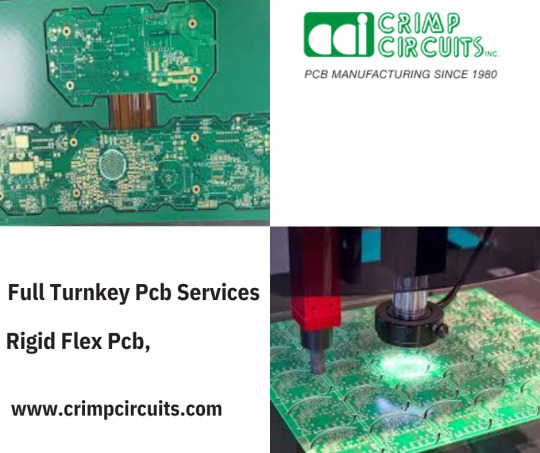
#pcb manufacturing toronto#printed circuit board design#metal clad pcb#printed circuits#rigid flex pcb#full turnkey pcb services#turnkey pcb services#pcb parts#eagle software#pcb designing#flexible pcb#pcb assembly#printed circuit board manufacturers#pcb manufacturers in canada#circuit board manufacturers in canada#pcb quote#pcb prototype services in canada
0 notes
Text
Leading Printed Circuit Board (PCB) Manufacturers: Top Companies in the Industry
Discover the top manufacturers in the printed circuit board (PCB) manufacturers industry, known for their cutting-edge technology, high-quality production, and reliable service. This guide highlights leading PCB manufacturers renowned for their expertise in designing and producing various types of PCBs, from simple single-layer boards to complex multi-layer and high-frequency circuits. Whether you’re looking for domestic or international suppliers, find detailed information on each company’s capabilities, specialties, and commitment to innovation, helping you choose the best partner for your electronic manufacturing needs. For more details visit our website www.crimpcircuits.com
#pcb manufacturing toronto#printed circuit board design#metal clad pcb#printed circuits#rigid flex pcb#full turnkey pcb services#turnkey pcb services#pcb parts#eagle software#pcb designing#flexible pcb#pcb assembly#printed circuit board manufacturers#pcb manufacturers in canada#circuit board manufacturers in canada#pcb quote#pcb prototype services in canada
0 notes
Text
Request for Quote on Custom Printed Circuit Board (PCB) Manufacturing
We are seeking a detailed quote for the design, manufacturing, and assembly of custom Printed Circuit Boards PCBs quote. The project includes specific requirements regarding board dimensions, material types, layer count, surface finish, and component placements. Please provide breakdowns for prototyping, production volume, lead time, and additional services such as testing and quality control. We are open to discussions on optimization and cost-saving alternatives without compromising quality. For more details visit our website www.crimpcircuits.com
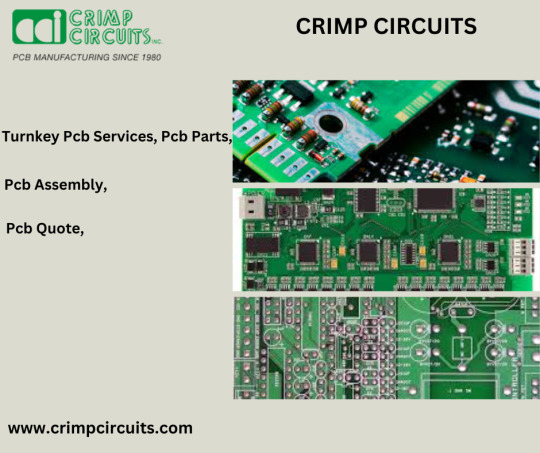
#pcb manufacturing toronto#printed circuit board design#metal clad pcb#printed circuits#rigid flex pcb#full turnkey pcb services#turnkey pcb services#pcb parts#eagle software#pcb designing#flexible pcb#pcb assembly#printed circuit board manufacturers#pcb manufacturers in canada#circuit board manufacturers in canada#pcb quote#pcb prototype services in canada
0 notes
Text
Understanding Metal-Clad PCBs: A Comprehensive Guid
In the realm of electronics, the printed circuit board (PCB) is the backbone of virtually every device, providing the essential pathways for electrical signals. Among the various types of PCBs, metal-clad PCBs stand out due to their unique thermal and electrical properties. This blog delves into what metal-clad PCBs are, their benefits, applications, and considerations for use.
What Are Metal-Clad PCBs?
Metal-clad PCBs, often referred to as metal-core PCBs (MCPCBs), are a type of circuit board where a metal layer is used as the base material. Unlike traditional PCBs, which typically use a fibreglass-reinforced epoxy laminate, metal-clad PCBs feature a metal base, commonly aluminum or copper. This metal layer is sandwiched between the dielectric layer (which provides electrical insulation) and the copper circuit layer.
Benefits of Metal-Clad PCBs
Enhanced Thermal Management: One of the most significant advantages of metal-clad PCBs is their superior thermal conductivity. The metal core helps dissipate heat more effectively compared to traditional PCBs. This property is crucial for high-power applications where heat management is a critical concern.
Improved Durability: Metal-clad PCBs are more durable and resistant to mechanical stress. The metal core provides added strength and resistance to thermal cycling, making them ideal for demanding environments.
Reduced Thermal Expansion: Metal-clad PCBs exhibit lower thermal expansion compared to traditional boards. This stability helps in maintaining the integrity of the PCB under fluctuating temperatures, reducing the risk of warping or cracking.
Compact Design: The enhanced thermal conductivity allows for more compact designs. Engineers can design smaller and more efficient circuits without compromising on performance, which is particularly beneficial in space-constrained applications.
Applications of Metal-Clad PCBs
Metal-clad PCBs are widely used in various industries due to their thermal and mechanical properties. Here are some common applications:
LED Lighting: Metal-clad PCBs are commonly used in LED lighting applications due to their excellent thermal management. LEDs generate significant heat, and metal-clad PCBs help dissipate this heat efficiently, enhancing the lifespan and performance of the LEDs.
Power Electronics: In power electronics, metal-clad PCBs are used in devices like power supplies and converters. The ability to handle high power and manage heat effectively makes them ideal for these applications.
Automotive Industry: The automotive sector uses metal-clad PCBs in components such as control units and sensors. The durability and thermal stability of these PCBs are crucial for reliable operation in harsh automotive environments.
Telecommunications: Metal-clad PCBs are used in telecommunications equipment, including base stations and signal processing devices. Their thermal management properties ensure stable performance in high-frequency and high-power applications.
Considerations for Metal-Clad PCBs
While metal-clad PCBs offer numerous benefits, there are several considerations to keep in mind:
Cost: Metal-clad PCBs generally cost more than traditional PCBs due to the materials and manufacturing processes involved. However, the long-term benefits in terms of performance and durability can outweigh the initial investment.
Design Complexity: Designing metal-clad PCBs requires careful consideration of thermal management and mechanical factors. Engineers need to account for the thermal conductivity of the metal core and its impact on the overall design.
Manufacturing Process: The production of metal-clad PCBs involves specialized techniques, including bonding the metal layer to the dielectric and ensuring proper heat dissipation. It’s essential to work with a manufacturer experienced in metal-clad PCB production to achieve optimal results.
Conclusion
Metal-clad PCBs represent a significant advancement in PCB technology, offering enhanced thermal management, durability, and compact design possibilities. Their applications span across various industries, from LED lighting to automotive and telecommunications. While they come with considerations such as cost and design complexity, their benefits make them a valuable choice for high-power and high-performance applications. As technology continues to evolve, metal-clad PCBs will likely play an increasingly crucial role in meeting the demands of modern electronics. For more details visit our website www.crimpcircuits.com
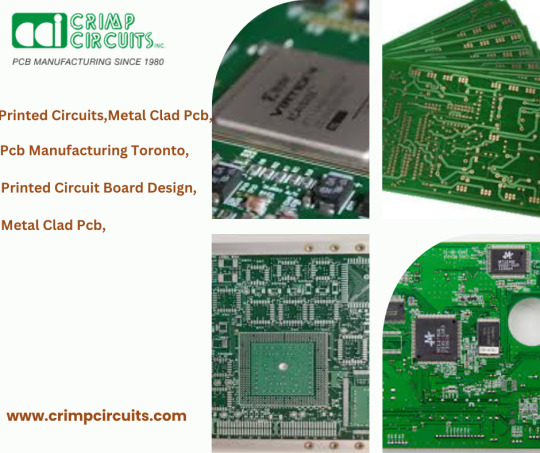
#pcb manufacturing toronto#printed circuit board design#metal clad pcb#printed circuits#rigid flex pcb#full turnkey pcb services#turnkey pcb services#pcb parts#eagle software#pcb designing#flexible pcb#pcb assembly#printed circuit board manufacturers#pcb manufacturers in canada#circuit board manufacturers in canada#pcb quote#pcb prototype services in canada
0 notes
Text
Printed Circuit Board Manufacturers: Overview and Key Considerations
Printed circuit board (PCB) manufacturers are specialized companies that produce PCBs, a crucial component in virtually all electronic devices. These manufacturers handle the fabrication and assembly processes, including etching the circuit patterns onto the board, drilling holes, and applying solder mask and silkscreen layers. Key considerations for selecting a PCB manufacturer include their production capabilities, quality control standards, material options, and lead times. Manufacturers may offer various types of PCBs, such as single-sided, double-sided, and multi-layer boards, each suited for different applications. Additionally, some manufacturers provide value-added services like prototype development, assembly, and testing. Choosing the right PCB manufacturer is essential for ensuring the reliability, performance, and cost-effectiveness of electronic products. For more details visit our website www.crimpcircuits.com
#pcb manufacturing toronto#printed circuit board design#metal clad pcb#printed circuits#rigid flex pcb#full turnkey pcb services#turnkey pcb services#pcb parts#eagle software#pcb designing#flexible pcb#pcb assembly#printed circuit board manufacturers#pcb manufacturers in canada#circuit board manufacturers in canada#pcb quote#pcb prototype services in canada
0 notes
Text
Request for PCB Quote: Key Information and Process
A PCB quote provides a detailed estimate of the cost and specifications for manufacturing printed circuit boards (PCBs). When requesting a PCB quote, key information typically required includes the PCB design files (such as Gerber files), the desired quantity, board dimensions, material specifications, layer count, and any additional requirements like surface finishes or solder mask colors. The quote process involves evaluating these details to determine the manufacturing costs, including material, labor, and setup expenses. Accurate quoting is essential for budget planning and ensures that the final product meets the required standards and specifications. This process helps clients understand the financial aspects of their PCB projects and plan accordingly. For more details visit our website www.crimpcircuits.com

#pcb manufacturing toronto#printed circuit board design#metal clad pcb#printed circuits#rigid flex pcb#full turnkey pcb services#turnkey pcb services#pcb parts#eagle software#pcb designing#flexible pcb#pcb assembly#printed circuit board manufacturers#pcb manufacturers in canada#circuit board manufacturers in canada#pcb quote#pcb prototype services in canada
0 notes